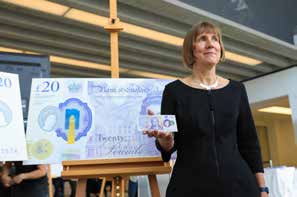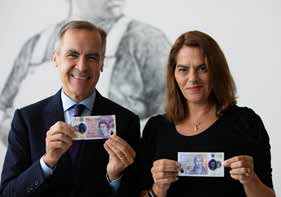
Sarah John
FIND OUT MORE ABOUT THE POLYMER £20 NOTE
SARAH JOHN TALKS TO SPINK ABOUT THE POLYMER £20 NOTE – THE FIRST NOTE TO FEATURE HER SIGNATURE AS CHIEF CASHIER AND DIRECTOR OF NOTES AT THE BANK OF ENGLAND
On 10th October, my team and I set off for a slightly unusual day of work … at the seaside. We were there to unveil the new £20 note featuring JMW Turner at Turner Contemporary in sunny, if somewhat blustery, Margate.
For some of my team, this marked the end of a long journey, and for others, just the beginning. It started back in May 2015, when we asked the public to nominate the visual artist they would most like to appear on the £20. This was the first time we’d ever asked the public for their suggestions and our committee had the unenviable job of whittling down the 590 names we received to a shortlist of just five. The Governor, Mark Carney, then chose Turner and the design process could begin.
Researching and bringing together elements of Turner’s life into a banknote design was down to a team of design experts, all working in top secret. They were tasked with designing an attractive note representative of Turner and his work, whilst including the security features that are so important for deterring counterfeiters but at the same time are easy for the public to check.
Our design – the finer details
Two-colour foil celebrating Turner’s connection to Margate
The first thing you are likely to notice on the front of the note is the striking blue and gold foils in the large see-through window. This is the first time we have ever used a two-colour foil, which shows the Margate Lighthouse in gold and Turner Contemporary art gallery in blue. Turner regularly visited and painted Margate and the town was close to his heart.
The Fighting Temeraire and Turner’s self-portrait.
We have used an engraving of Turner’s self-portrait, painted when he was approximately twenty-four years old. Although relatively young, it was around this time that he became an Associate of the Royal Academy and he had already been earning money from the sales of his paintings for a number of years. This is shown in ledgers at the Bank of England, which record his finances and can be viewed in the small exhibit ‘Painting a fortune: Turner and the Bank of England’ at our Museum in the City of London.
Turner’s painting ‘The Fighting Temeraire’ appears alongside his self-portrait. The original painting was a tribute to the gunship HMS Temeraire. It shows the famous gunship, decades after Nelson’s victory at the Battle of Trafalgar in 1805, being towed on its final journey toward the Rotherhithe shipyard where it was to be broken up.
This painting, which was voted the UK’s favourite in a 2005 BBC poll, displays Turner’s wonderful use of light and colour.
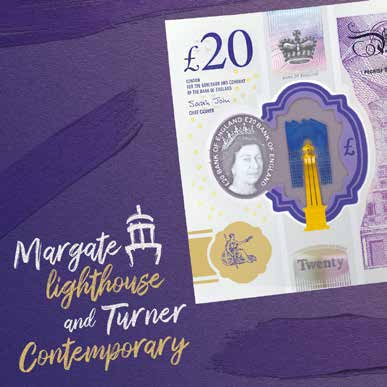
Two see-through windows to make our most secure note yet
The shape of the large window is based on the shape of the fountains in Trafalgar Square, which sit just outside of the National Gallery where ‘The Fighting Temeraire’ is exhibited. A second, smaller see-through window in the bottom corner of the note was inspired by Turner’s painting of Tintern Abbey in South Wales. Like the two-colour foil, this is the first time we have included two windows on a note. These two security features combined are what make it our most secure note yet.
“Light is therefore colour” quote and Turner’s signature.
Underneath Turner’s portrait is the quote “Light is therefore colour” from his 1818 lecture referring to the innovative use of light, shade, colour and tone in his pictures. This can be found just below his signature. Fans of Turner might already know that many of his works were unsigned, so we have taken his signature from his Will, the document with which he gave many of his paintings to the nation, comprising 300 oil paintings and 30,000 sketches.
Behind the coronation crown at the top of the note, there is a purple foil patch containing the letter ‘T’ which is based on the staircase at the Tate Britain, where Turner’s self-portrait is on display and which now houses much of the Turner’s work in the Clore Gallery.
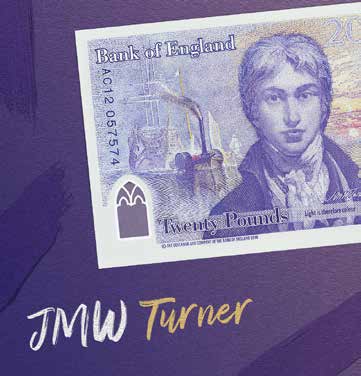
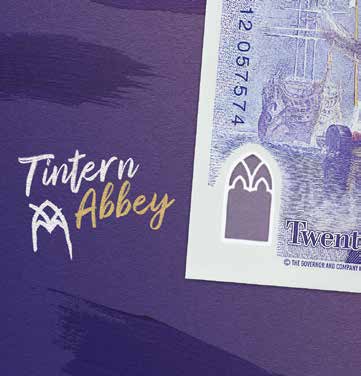
Once we were happy with the full design, it was onto a job I was especially excited about – the Chief Cashier’s signature. This new £20 is the first note that will have my signature and it’s a huge privilege to be signing on behalf of the Bank of England.
The £20 is the UK’s highest volume note. Preparing for this note has been a huge undertaking. In addition to the detailed design work, this has involved printing 24 hours a day, five days a week for the best part of a year to print enough notes to be ready to launch,
and we are continuing to work closely with the cash industry to make sure that cash acceptance and dispensing machines are ready for the issue in February. And while the launch stock for the £20 is now complete, our work is not yet finished. Our attentions are now turning to a new £50 note, featuring Alan Turing, which will follow in 2021, completing our first full denomination set of Bank of England polymer banknotes.
Low number notes
The JMW Turner £20 will be issued on 20th February 2020. While the lowest serial numbers are given to members of royalty, other officials and institutions closely associated with the character, (AA01 000001 is traditionally given to the Queen) I am pleased to announce that we will be holding a charity auction of low serial number £20 notes with Spink in London following the issue.

The proceeds of the auction will be donated to three charities to be announced shortly. Perhaps we are biased, but in our opinion the new £20 is a work of art – fitting for the note which features the artist, Turner, famed for his use of light, shade, colour and tone. The auction will be held at Spink on 8th April 2020 at 5pm – I will look forward to seeing you there.
The Bank of England Museum is free of charge to visit and open Monday to Friday 10-5pm.
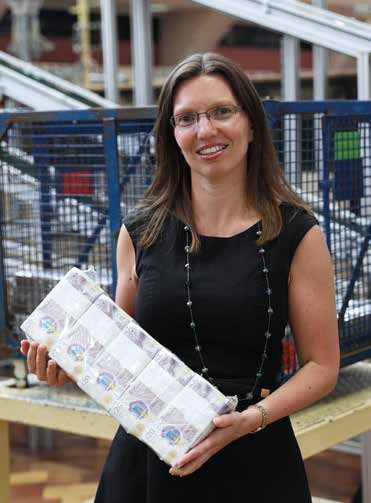
The original painting was a tribute to the gunship HMS Temeraire. It shows the famous gunship, decades after Nelson’s victory at the Battle of Trafalgar in 1805, being towed on its final journey toward the Rotherhithe shipyard where it was to be broken up.

